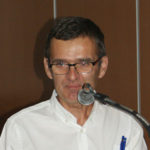LE Gayet, Ch Labarre (Poitiers)
Introduction : Les reprises cotyloïdiennes posent des problèmes lorsque la perte de substance osseuse est importante : stades III A et III B de la classification de Paprosky. Parmi toutes les techniques à notre disposition, une armature cotyloïdienne sur mesure obtenue après un simple scanner associé à une allogreffe parait une solution élégante.
Materiel et methodes : De 2015 à 2017 nous avons opéré 8 patients par cette technique. Trois femmes et cinq hommes : âge moyen 72 ans (60 à 83). Suivi moyen 18 mois (6-36 mois).Un scanner pré opératoire est suffisant. Il y avait 4 stades III A et 4 stades III B de la classification de Paprosky. Le laboratoire Serf ® fabriquait l’armature cotyloïdienne en 6 semaines après validation par le chirurgien et accord de la pharmacie et de la CPAM qui ont toujours obtempéré. La reconstruction osseuse a toujours été assurée par une ou deux demi- têtes TBF ® d’os lyophilisé avant la mise en place l’armature cotyloïdienne qui était vissée. Un cotyle double mobilité a été ensuite cimenté dans l’armature. Le changement à été bipolaire 5 fois sur 8. Le huitième patient présentait une pseudarthrose d’une fracture comminutive du cotyle et une allergique au ciment et au nickel l’insert en polyéthylène s’articulait directement avec l’armature en titane L’appui contact avec deux béquilles était autorisé pour trois mois en attendant l’ostéointégration.
Résultats : Le score d’Oxford passe de 6 à 30 en post-opératoire. Nous n’avons aucune luxation à déplorer. Nous avons eu un sepsis précoce qui a été lavé au dixième jour avec changement de l’insert ce qui a sauvé le montage. Nous avons aussi eu une paralysie du SPE qui a récupéré. Le recul est bien sur insuffisant mais pour l’instant nous ne déplorons aucune migration d’implant ce qui semble prouvez que l’ostéointégration des allogreffes est satisfaisante à court terme.
Discussion et conclusion : Les reprises cotyloïdiennes posent parfois des problèmes lorsque la perte de substance osseuse est importante. Grâce à cette armature cotyloïdienne sur mesure associé à une allogreffe nos huit patients ont pu reprendre une autonomie satisfaisante alors que 3 d’entre deux ne circulaient plus qu’en fauteuil roulant. Un simple scanner est suffisant pour fabriquer cet implant. Chez le patient allergique au ciment et au nickel le cotyle double mobilité en titane était livré solidaire de l’armature. Le prix avoisine les 3500 euros et nous utilisons cette technique environ deux fois par an en moyenne depuis 2015. Il existe une ligne LPPR de remboursement pour cet implant sur mesure. Les conclusions ne sont pas définitives mais cette technique simple à mettre en œuvre permet de traiter des cas complexes.
Introduction : Acetabular revision surgeries create problems when the loss of bone substance is important: levels IIIA and IIIB of the classification of Paprosky.
Amongst all the techniques available to us, a customized acetabular frame, obtained after a standard tomodensitometry, associated with a bone allograft seems to be an elegant solution
Material and method : Between 2015 and 2017 we have operated 8 patients using this technique. Three women and five men:72 years old average (60 to 83) Mean follow-up: 18 months (6 to 36 months). A preoperative tomodensitometry is sufficient. There were 4 stages IIIA and 4 stages IIIB of the classification of Paprosky. The Serf ® Laboratory manufactured the acetabular frame within 6 weeks after the surgeon’s validation and the agreement of the pharmacy and the healthcare insurance which always complied with the surgeon’s decision.
The bone reconstruction was always provided by one or two half femoral heads TBF® of lyophilized bone before the implementation of the acetabular frame, which was screwed.
A dual mobility acetabular cup was then cemented in the frame. The change was bipolar 5 times out of 8. The eighth patient was suffering from a pseudarthrosis of a comminuted fracture of the acetabular cup and an allergy to cement and nickel. The polyethylene insert was directly articulated with the titanium frame A two cruches partial weight bearing was allowed for three months while awaiting the osseointegration.
Results : The post-operative Oxford hip score increases from 6 to 30. We do not observe any dislocation. One early sepsis appeared. A surgical washing was practised on the tenth day, associated with the change of the insert, which saved the assembly. There was also one paralysis of the peroneal nerve, which recovered. The hindsight is of course insufficient but, for the time being, there are no migration of implants, which seems to prove that the osseointegration of the allografts is satisfying in a short term.
Discussion and conclusion : Acetabular revision surgery sometimes causes problems when the loss of bone substance is important
Using this tailor-made acetabular frame associated with a bone allograft allowed our eight patients to regain a satisfying degree of autonomy whilst three of them were only able to move in a wheelchair. A standard tomodensitometry is sufficient to manufacture this implant.
For the patient who is allergic to cement and nickel , the dual mobility titanium acetabular cup was delivered in one piece, joined to the frame. The price ranges around 3500 euros and we have been using this technique about twice a year since 2015. The refund of this type of customized implant is a part of the List of Products and Health Benefits reimbursed by the Social Healthcare Service. These conclusions are not definitive but this technique, easy to apply, enables us to treat complex cases.


